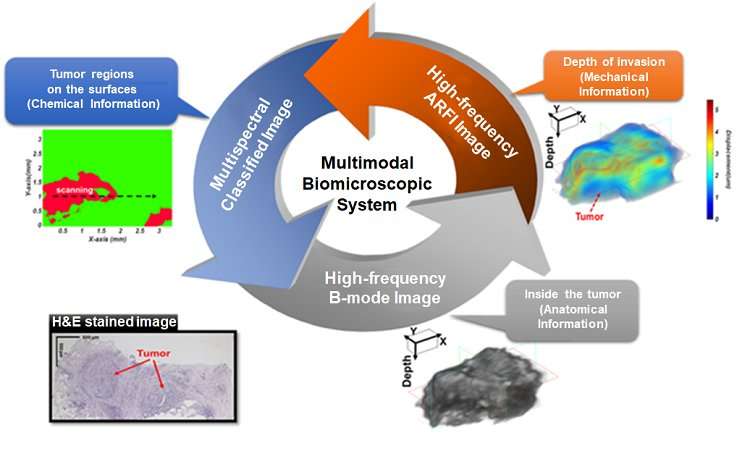Multimodal biomicroscopic system enhances the accuracy of cancer treatment

A research team of Information and Communication Engineering at DGIST has developed the world's first multimodal biomicroscopic system to analyze the characteristics of tumors and to utilize them in tumor treatment technology research. The new imaging system accurately analyzes the characteristics of tumors using the mechanical, chemical, and structural properties of colorectal cancer. It is the result of a collaboration with the research team of Eunjoo Kim from the Department of Nano & Energy Research.
Histopathologic examination of tumors removed during surgery is important. In particular, if a small part of the tumor is left in the patient, it becomes the cause of cancer recurrence or metastasis. Therefore, it is necessary to accurately analyze the removed tumor to find out whether cancer remains in the surgical site.
For analysis, it is necessary to send a resected tumor to a pathologist to examine the specimen with a microscope to determine whether the resected cancer tissue is appropriately acquired and whether additional resection of the tissue during surgery is necessary. However, this process is time consuming, and the results may vary depending on internal and external factors. To overcome these disadvantages, optical microscopy or ultrasonic wave technology are used. However, it is difficult to perform close inspection, as these methods have low resolution and cannot analyze the tissue internally.
Professor Hwang's research team has developed a converged biomicroscope based on high-frequency ultrasound and optical spectroscopy to overcome the disadvantages of the imaging systems previously developed for tumor analysis. The multimodal biomicroscopic system is capable of performing pathologic analysis simultaneously to detect the surface of resected tissues and tumors deep within the tissues during the cancer operation. It converges optical multispectral imaging, high-frequency ultrasound B-mode, and high-frequency ultrasound radiation imaging techniques.
Tissue and tumor areas can be analyzed more precisely than via a general fluorescence microscope as the optical spectroscopic imaging technique quantitatively analyzes the spectroscopic indicators emitted from the tissue surface. It is possible to detect deep tissue as well as tumor areas accurately with high frequency ultrasonic b-mode and high frequency ultrasonic radiation force imaging technique, as they image the impedance and elasticity inside the tissue at higher resolution than the existing ultrasonic imaging techniques.
Through the experiment, the research team has proved that multimodal biomicroscopic system enables mechanical, chemical, and structural analysis of the tumor tissue from colon cancer patients at the high resolution from the surface to the deep of the tumor.
Professor Hwang said, "We have developed a multimodal biomicroscopic system based on high-frequency ultrasound and optical spectroscopy for the first time. It complements the disadvantages of the existing image analysis systems. We will conduct further studies to develop this system to the endoscope system which can be used for clinical diagnosis of cancer before the actual surgery."
The results of this study show that the multimodal biomicroscopic system has the potential to qualitatively investigate the characteristics of incised tumors in vitro. The multimodal biomicroscopic system is expected to improve the efficiency and success rate of cancer surgery by increasing the accuracy of tumor removal surgery as well as shortening the operation time.
More information: Jihun Kim et al, A Multimodal Biomicroscopic System based on High-frequency Acoustic Radiation Force Impulse and Multispectral Imaging Techniques for Tumor Characterization Ex vivo, Scientific Reports (2017). DOI: 10.1038/s41598-017-17367-1















